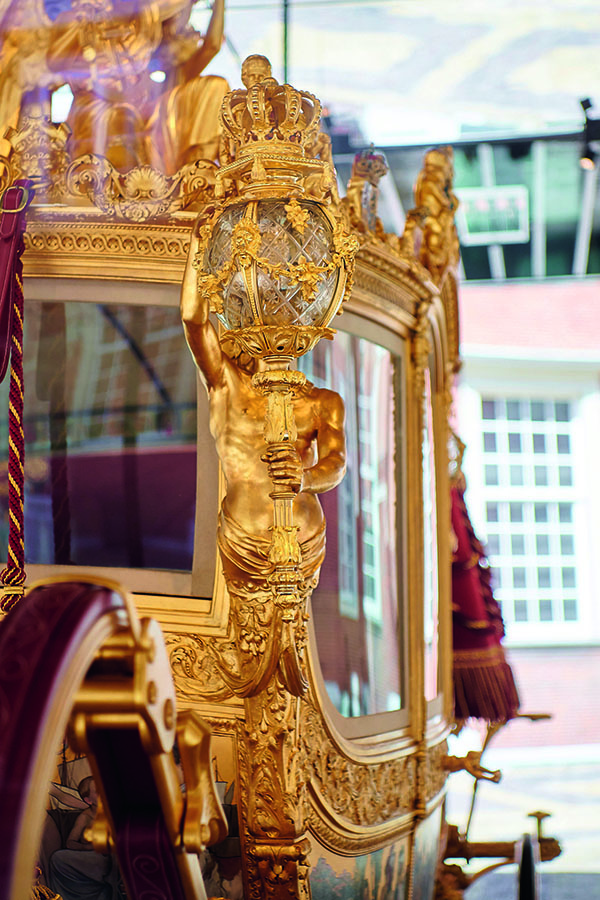After a restoration of more than five years, the Dutch Royal Golden Carriage is on show for the first time in the Amsterdam Museum. For the duration of the exhibition, the carriage returns to Amsterdam, the city that gave it to Queen Wilhelmina in 1898. In six rooms around the courtyard, all with a view of the Golden Carriage (Gouden Koets), hundreds of historical objects, paintings, Oranje trinkets, clothing, cartoons, photos and films are displayed that shed light on the turbulent history of the country’s most famous vehicle from all viewpoints.
The Golden Carriage was Amsterdam’s present at the inauguration of the first woman on the Dutch throne, 18-year-old Queen Wilhelmina. Amsterdam was buzzing again at the end of the 19th century, after a long period of stagnation. City walls were replaced by train stations, factories, luxury hotels and new neighbourhoods. The population doubled in thirty years. Socialism arose, young people sought their own way and churches were restless. The need for a connecting symbol grew and that was found, as several times before in history, in the House of Orange. After the unpopular King Willem III (1817-1890), 18-year-old Wilhelmina (1880-1962) appealed to public imagination. The gift of the Golden Carriage confirmed her fairytale story.
Support and opposition
Since Wilhelmina’s accession to the throne, the carriage has known fans and critics, because the carriage symbolizes the House of Orange, democracy, the self-confident capital Amsterdam, the fairytale of royalty and the Kingdom of the Netherlands. Today, the colonial past also plays a role. In the exhibition, the visitor meets the creators and builders of the carriage, later spectators and protestors, descendants of the people depicted on the carriage, and of course the users: the Oranjes.
The carriage today
The exhibition does not shy away from a question. Even the question of whether it is desirable that the carriage remains in use on Prinsjesdag after the restoration and during Oranje weddings and inaugurations is prominently featured. Should the Golden Carriage be made future-proof or should it be moved to a museum? The Amsterdam Museum invites visitors to share their views and to create an alternative Golden Carriage using augmented reality. During the exhibition, the museum travels with a mobile research installation to all provincial capitals, to share information about the carriage and to map out the various visions of the Golden Carriage in the Netherlands.
Modern art
Sixteen contemporary artists from different backgrounds and different generations reflect in works of art on the symbolic value and materiality of the carriage, including the controversial panel on the carriage ‘Homage by the Colonies’, in which the Dutch colonies are depicted praising the Dutch nation. Their installations, sculptures, painting, photography, sound art and performances offer artistic and critical perspectives on the Golden Carriage. Artistic director of the Amsterdam Museum Margriet Schavemaker: ‘With this exhibition, the Amsterdam Museum wants to facilitate debate about the value and future of the Golden Carriage. The contributions of the artists are of great importance in this regard. Their contributions give rise to multiple imaginations and diverse perspectives. These are an important addition to the existing heritage, which often shows a one-sided narrative of history.’ The museum’s monumental, twelve-meter-high Amsterdam Gallery will be furnished for this exhibition with contemporary works of art, some of which have also been included in the exhibition route. Three site-specific works are presented and performances take place in the courtyards of the museum. The Golden Carriage itself is displayed in a glass enclosure in the main courtyard of the museum. This special construction allows visitors to get very close to it.
The Golden Carriage
Until 27 February 2022
www.amsterdammuseum.nl
